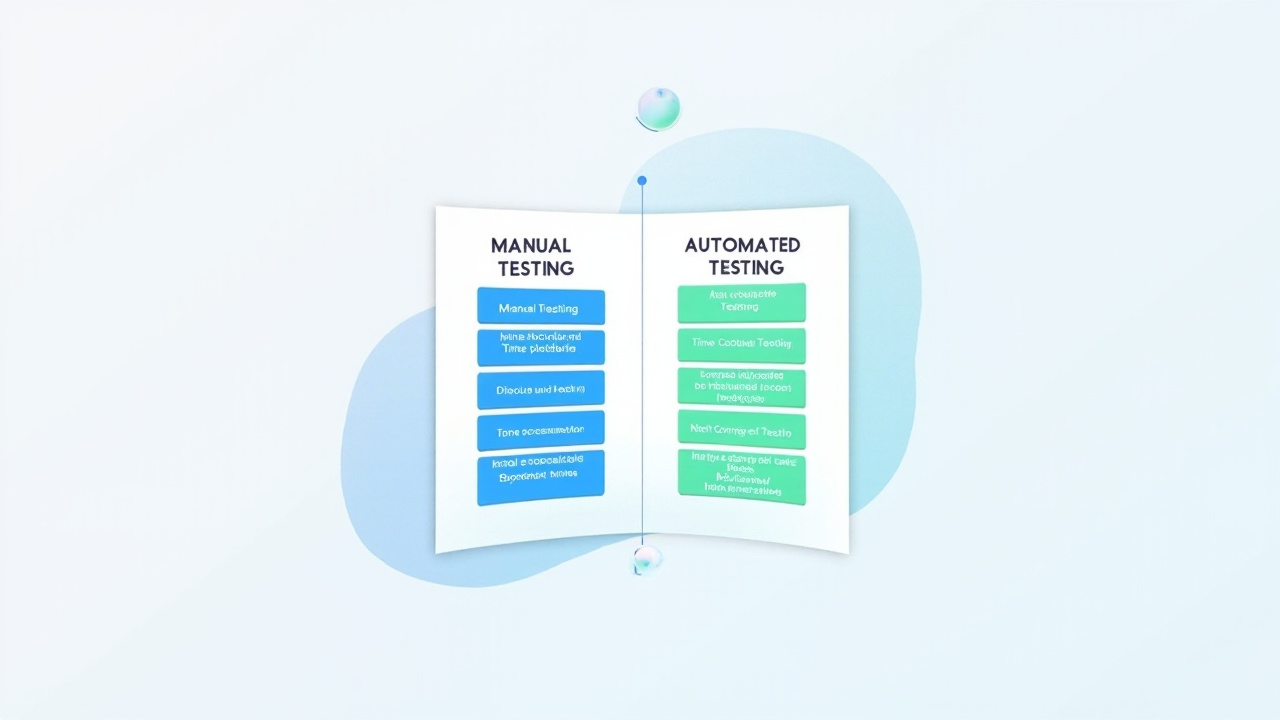The Ultimate Guide to Software Testing: Strategies and Insights for Success
In the fast-paced world of software development, ensuring the quality and reliability of applications is paramount. Software testing plays a crucial role in this process, acting as a safeguard against bugs and vulnerabilities that could compromise user experience and security. But what exactly is software testing, and how can it be done effectively? In this comprehensive guide, we will delve into the intricacies of software testing, exploring its methodologies, best practices, and the latest trends shaping the industry.
The journey into software testing begins with understanding its fundamental purpose: to ensure that software applications are reliable, secure, and user-friendly. As software becomes increasingly complex, testing has evolved from a mere afterthought to an integral component of the software development lifecycle (SDLC). This evolution is driven by the need to deliver high-quality products in a competitive market where users expect seamless performance.
Despite its critical importance, many organizations struggle with implementing effective software testing strategies. Common pain points include insufficient planning, lack of standardized processes, and inadequate testing coverage. This guide aims to address these challenges by providing actionable insights and practical applications. By the end of this article, you will have a deeper understanding of software testing and how to apply its principles to enhance the quality of your applications.
Understanding the Software Testing Lifecycle

The Software Testing Lifecycle (STLC) is an integral part of the software development process. It outlines the phases involved in testing a software product, from initial planning to the final evaluation. Understanding and effectively implementing each phase of the STLC can significantly enhance the quality and reliability of the software.
Phases of the STLC
- Requirement Analysis: The first phase involves understanding the software requirements. Testers collaborate extensively with stakeholders, including developers, business analysts, and end-users, to identify what needs to be tested and define clear objectives. This phase is crucial for establishing a strong foundation for the entire testing process. By thoroughly analyzing the requirements, testers can develop a comprehensive understanding of the application’s functionality and potential pain points.
- Test Planning: A comprehensive test plan is developed, detailing the scope, objectives, resources, and schedule of the testing activities. The test plan also defines the testing environment and tools to be used. This phase is pivotal in aligning the testing process with the overall project goals. By involving all relevant stakeholders in the planning process, potential risks can be identified and mitigated early on, ensuring a more streamlined and efficient testing process.
- Test Case Development: During this phase, test cases are designed based on the requirements. This involves creating detailed test scripts and data sets to ensure comprehensive coverage of all functionalities. Test cases should be clear, concise, and easily executable, allowing testers to systematically verify each feature of the application. Effective test case development is key to achieving thorough test coverage and identifying defects before they reach the end-user.
- Test Environment Setup: A suitable testing environment is established, replicating the production environment as closely as possible to ensure accurate results. This phase involves configuring hardware and software resources, setting up test data, and preparing necessary tools. A well-structured test environment is crucial for identifying environment-specific issues and ensuring the reliability and performance of the application.
- Test Execution: Testers execute the test cases and document the outcomes. Any defects discovered are logged for further analysis and resolution. Test execution is an iterative process, requiring collaboration between testers and developers to identify the root cause of defects and implement necessary fixes. This phase also involves retesting and regression testing to verify that defects have been resolved and no new issues have been introduced.
- Test Cycle Closure: The final phase involves evaluating the testing process, identifying lessons learned, and preparing a closure report. This ensures continuous improvement for future projects. A comprehensive test cycle closure involves analyzing test metrics, such as defect density and test coverage, to gauge the effectiveness of the testing process. By documenting lessons learned, organizations can refine their testing strategies and improve the quality of future releases.
“A well-executed STLC ensures that testing is conducted systematically and efficiently, minimizing risks and maximizing software quality.”
Diverse Testing Levels and Their Importance

Software testing is not a one-size-fits-all approach; it encompasses various levels, each with a distinct purpose and focus. Understanding the different testing levels is essential for ensuring comprehensive test coverage and delivering a robust software product.
Unit Testing
Unit testing is the foundational level of testing, where individual components or modules are tested in isolation. This level of testing is typically performed by developers and focuses on verifying the functionality of specific code units, such as functions or classes. Unit tests are often automated, allowing for rapid feedback and early defect detection. By identifying issues at an early stage, unit testing reduces the cost of fixing defects later in the development cycle and enhances code quality.
Integration Testing
Integration testing focuses on verifying the interactions between different modules or systems. This level of testing is crucial for identifying issues related to data exchange, communication protocols, and interface compatibility. Integration tests can be performed using various approaches, such as top-down, bottom-up, and sandwich testing. By ensuring that integrated components work together as intended, integration testing helps prevent interface-related issues and ensures seamless system integration.
System Testing
System testing evaluates the complete and integrated software product. It assesses the system’s compliance with specified requirements and ensures that it meets the user’s needs. System testing is a critical phase that involves executing end-to-end test scenarios to validate the application’s functionality, performance, and security. By simulating real-world usage conditions, system testing provides valuable insights into the application’s behavior and helps identify potential bottlenecks or vulnerabilities.
Acceptance Testing
Acceptance testing is the final level, conducted to determine whether the software is ready for deployment. This level of testing involves real-world scenarios and end-user participation to validate the software’s functionality and usability. Acceptance testing can be divided into two types: user acceptance testing (UAT) and business acceptance testing (BAT). UAT focuses on verifying that the application meets user expectations, while BAT ensures that the software aligns with business objectives. By involving end-users in the testing process, acceptance testing provides valuable feedback and ensures that the software is fit for purpose.
“Effective testing at each level is crucial for delivering a robust and reliable software product.”
Exploring Various Testing Methods

The choice of testing method can significantly impact the effectiveness of the testing process. Here, we explore the most common methodologies used in the industry, each with its advantages and limitations.
Manual Testing
Manual testing involves human intervention to execute test cases. It is ideal for exploratory and usability testing, where human intuition and judgment are essential. Testers manually execute test scenarios and validate the application’s behavior against expected outcomes. Manual testing is particularly effective for identifying usability issues, visual defects, and user experience anomalies. However, manual testing can be time-consuming and prone to human error, especially for large-scale applications with frequent updates.
Automated Testing
Automated testing uses tools and scripts to execute tests automatically. This method is highly efficient for regression testing and repetitive tasks, allowing testers to focus on more complex scenarios. Automated testing involves writing test scripts using programming languages or automation frameworks, such as Selenium, JUnit, or TestNG. By automating test execution, organizations can achieve faster feedback loops, reduce testing time, and improve test coverage. Selecting the right automation tools and frameworks is crucial for success, as they must align with the project’s technology stack and testing requirements.
Performance Testing
Performance testing assesses the software’s speed, scalability, and stability under various conditions. This type of testing is essential for identifying bottlenecks and ensuring that the application can handle expected user loads. Performance testing involves simulating different user loads and measuring key performance indicators, such as response time, throughput, and resource utilization. Performance testing can be further categorized into load testing, stress testing, endurance testing, and volume testing, each focusing on different aspects of system performance.
Security Testing
Security testing aims to identify vulnerabilities that could be exploited by attackers. This type of testing involves penetration testing, vulnerability scanning, and risk assessment to protect the software from potential threats. Security testing is critical for safeguarding sensitive data and ensuring compliance with industry standards and regulations. By simulating real-world attack scenarios, security testing helps organizations identify and mitigate security risks, enhancing the overall security posture of the application.
“The right mix of manual and automated testing methods can enhance the testing process, ensuring thorough coverage and efficiency.”
Embracing Best Practices in Software Testing

Implementing best practices in software testing can significantly enhance its effectiveness and efficiency. By adopting proven strategies and methodologies, organizations can improve test coverage, reduce defects, and deliver high-quality software.
Early Involvement of Testers
Involving testers early in the development process allows for better understanding of the requirements and early identification of potential issues. This proactive approach leads to more effective testing strategies and reduces the risk of defects reaching the production environment. By collaborating with developers and business analysts during the requirement analysis and design phases, testers can provide valuable insights and ensure that testability is considered from the outset.
Comprehensive Test Planning
A well-defined test plan is essential for guiding the testing process. It should outline the scope, objectives, resources, and schedule, ensuring alignment with project goals. A comprehensive test plan provides a roadmap for the testing activities and helps manage stakeholder expectations. By clearly defining test deliverables, entry and exit criteria, and risk mitigation strategies, organizations can ensure a structured and efficient testing process.
Continuous Integration and Testing
Continuous integration and testing involve integrating code changes frequently and testing them immediately. This approach helps catch defects early and accelerates the feedback loop. By automating build and deployment processes, organizations can ensure that every code change is tested and validated before merging into the main codebase. Continuous integration and testing reduce the risk of integration issues and ensure that the software is always in a releasable state.
Leveraging Test Automation
Test automation can significantly reduce testing time and effort. Prioritize automating repetitive and time-consuming tasks, allowing testers to focus on exploratory and advanced testing. By automating regression tests and smoke tests, organizations can achieve faster test execution and improve test coverage. However, it’s important to strike a balance between manual and automated testing, as certain test scenarios may require human intuition and expertise.
“Adopting best practices in software testing leads to higher quality software and more efficient testing processes.”
Overcoming Common Challenges in Software Testing

Despite its importance, software testing is fraught with challenges. Here, we explore some common obstacles and strategies to overcome them.
Limited Resources and Budget Constraints
Testing can be resource-intensive, requiring skilled personnel and advanced tools. Prioritizing testing efforts based on risk and impact can help manage limited resources effectively. By adopting a risk-based testing approach, organizations can focus on critical functionalities and high-risk areas, ensuring that resources are allocated where they are needed most. Additionally, leveraging open-source testing tools and frameworks can help reduce costs while maintaining testing quality.
Evolving Requirements
Requirements can change frequently during development, posing challenges for testers. Agile methodologies and flexible test planning can help adapt to these changes seamlessly. By adopting an iterative development approach, organizations can accommodate changing requirements and ensure that testing activities remain aligned with project objectives. Regular communication and collaboration between testers and stakeholders are crucial for managing evolving requirements and minimizing disruption.
Insufficient Test Coverage
Balancing comprehensive test coverage with time and resource constraints is a common challenge. Risk-based testing and prioritizing critical functionalities can optimize coverage. By identifying high-risk areas and focusing testing efforts on these areas, organizations can achieve maximum test coverage with limited resources. Additionally, adopting test-driven development (TDD) practices can help ensure that code is thoroughly tested and aligned with requirements from the outset.
Lack of Standardization
Inconsistent testing processes can lead to inefficiencies and errors. Establishing standardized procedures and guidelines ensures consistency and reliability. By implementing a standardized testing framework, organizations can streamline testing activities, improve communication, and enhance test quality. Establishing clear test documentation, such as test plans, test cases, and defect reports, can also help maintain consistency and facilitate knowledge sharing.
“Addressing challenges in software testing requires strategic planning, adaptability, and a focus on continuous improvement.”
Future Trends Shaping Software Testing

The field of software testing is continuously evolving, driven by technological advancements and changing industry demands. Here, we explore some emerging trends that are shaping the future of software testing.
Artificial Intelligence and Machine Learning
AI and ML are revolutionizing software testing by enhancing test automation, predictive analytics, and defect detection. These technologies can analyze vast amounts of data to identify patterns and optimize testing processes. By leveraging AI and ML, organizations can achieve faster test execution, improve test accuracy, and enhance defect prediction capabilities. AI-driven test automation tools can also generate test scripts and scenarios based on application behavior, reducing the need for manual scripting.
DevOps and Continuous Testing
The DevOps movement emphasizes collaboration between development and operations teams, integrating continuous testing into the development pipeline. This approach accelerates the delivery of high-quality software by ensuring that testing is an integral part of the development process. By adopting DevOps practices, organizations can achieve faster feedback loops, reduce deployment risks, and improve software quality. Continuous testing also enables organizations to deliver updates and new features more frequently, enhancing customer satisfaction and competitiveness.
Test-Driven Development
Test-driven development (TDD) involves writing tests before developing the actual code. This practice ensures that code is thoroughly tested and aligns with requirements from the outset. TDD encourages developers to think about testability during the design phase, leading to cleaner and more maintainable code. By adopting TDD, organizations can improve code quality, reduce defects, and enhance collaboration between developers and testers.
Shift-Left Testing
Shift-left testing advocates for testing early and often in the development process. This approach helps identify defects early, reducing the cost and effort of fixing them later. By integrating testing activities into the initial stages of the development lifecycle, organizations can achieve faster defect detection and resolution. Shift-left testing also encourages collaboration between developers, testers, and business stakeholders, ensuring that testing objectives are aligned with project goals.
“Embracing future trends in software testing can enhance testing efficiency, accuracy, and adaptability.”
In conclusion, software testing is a critical component of the software development process, ensuring that applications are reliable, secure, and user-friendly. By understanding the software testing lifecycle, exploring diverse testing methods, and embracing best practices, organizations can enhance their testing strategies and deliver high-quality software. As technology continues to evolve, staying informed about emerging trends will be essential for maintaining a competitive edge.
As you embark on your software testing journey, consider how these insights and strategies can be applied to your projects. By continuously refining your approach and embracing new technologies, you can ensure the success of your software testing efforts. Whether you’re a seasoned tester or new to the field, the ultimate goal is to deliver software that meets the highest standards of quality and performance.
“Software testing is not just a phase in the development process; it’s a commitment to excellence.”
For those eager to delve deeper into this fascinating field, there are numerous resources and communities dedicated to advancing software testing knowledge. Engage with fellow testers, participate in forums, and explore advanced testing techniques to stay ahead in this dynamic industry.
Explore More on This Topic
Interested in diving deeper into this subject? Connect with experts or explore additional resources to expand your understanding.
If the link above does not work, please visit: https://calendly.com/dm-csimplifyit/30min?month=2025-05